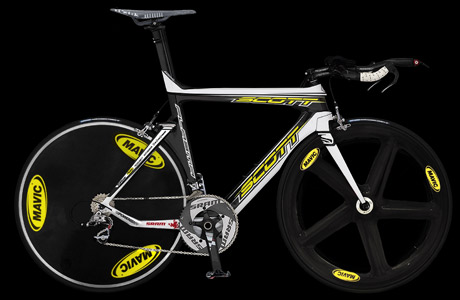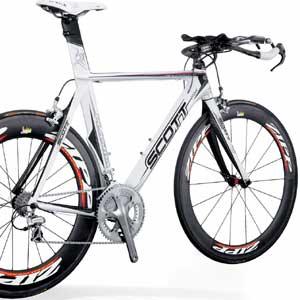
We had an inkling that something was in the works when Scott marketing manager Adrian Montgomery mentioned at Ironman 70.3 California about something they had up their sleeve. But he “couldn’t say anything.”
To me, that usually means: we’re coming out with a new bike: we’ll let you know. Nothing quite as frustrating as a tease.
It was good news, though, that they might had something on tap. While the Plasma was a great upon its debut with its industry-first cut-to-fit seat mast on its first dedicated tri bike, it needed some true tunnel testing to earn the credence of its consumer.
So it was to the drawing board. Scott used its in-house engineers, which included Charley French, the man who worked with Boone Lennon in creating of the first Scott aerobar. French was charged with managing Plasma 2 testing at the Colorado Premier Training low speed wind tunnel in Fort Collins, Colo. many months ago.
It was supposed to be debuted around the Tour de France, but some search-saavy Slowtwitchers found it in test under the Saunier Duval team in Europe. So the debut was moved up to now—the Giro d’Italia.
Montgomery said sponsored pro Linsey Corbin will likely be one of the lucky few with this new Scott rig in Kona. It’s name? The Plasma 2.

The details
Scott applies its Integrated Molding Process to the Plasma 2 (which has been seen on the existing Addict and Spark models within Scott’s road and MTB lines) in the frame’s creation. The process helps Scott control carbon wall thickness, permitting for added material at higher stress areas while running traditionally thinner walls at lower stress area of a tubeset, all while minimizing voids. Scott advances it by introducing IMP5—creating the main frame tubes (downtube, headtube, toptube and seat tube) at the same time.
Everything we knew bout CR1, about removing weight from the walls, all that morphed into IMP,” Montgomery said. “Now with IMP5, that’s process is done in one set. With that much shaping through the frame, If we hadn’t learned to apply IMP in one step, the bike would have weighed more.”
Scott also uses a proprietary carbon fiber (they call it High Modulus Xtreme, or HMX) as their own superlight carbon blend for the model.
As a whole, Scott says the Plasma 2 represents a 20 percent decrease in overall drag over the standard Plasma. “It’s a huge improvement,” Montgomery said. “We want to give our ProTour teams the best edge we can. When you look at what a TT does for a stage race, it can make or break a race. We need to give them the best assets possible.
“We did a lot of work with David Millar when he was with us,” Montgomery added. “We’re thrilled for him and what he has done so far with Slipstream, but while he was with us, he was a huge asset for us in designing this bike. We learned a lot.”
Hello…. triathlon? “Oh, for sure, the triathlon segment is truly who this bike is built for, and it gives us another competitive edge in the triathlon market,” Montgomery reminds us. “The Plasma was growing—I mean, we had the greatest bike growth on the pier in Kona last year—but while when the energy is still hot, we still want to show we’re driving. We’ll have a 47cm Contessa in this Plasma 2 platform, still the same depth of models. We’re stoked.
On its face, the Plasma II takes on major changes. One of the most visual is the use of Twin Turbo chainstays. While they take a drastic northernly bend as they drive back toward the rear dropouts, Scott says the design has aerodynamic function, cutting drag in comparison to standard stay designs.
The headtube/toptube connect is scalloped, creating one clean line from the headtube back along the frame.
They also have another story to tell: Shelter 127. That 127 refers to the degrees of total front and rear wheel coverage the frame provides. The downtube cowls the front wheel from the headtube back to the trailing edge of the downtube cutout a total of 47 degrees. Add to that the 80 degrees of rear wheel coverage from the seat tube cowling, and you have 127 degrees of aerodynamic coverage. “That represents, to the best of our knowledge, the greatest amount of front and rear wheel coverage on the market.”
The tubesets? Ah, the Achilles heel, suddenly solved. Scott says downtube and seattube will measure just 29.7 millimeters at its widest point, at a depth of 78.95mm. Scott’s own competitive analysis puts Cervelo’s tube width at 29.2mm, Felt at 34.5 and Kuota at 38.1. The chainstays will be 11mm wide.
The Minutae
The frame is slated to weigh in (for a medium) at 1,340 grams, with the fork weighing 400 grams. It will features horizontal dropouts, as well as a replaceable derailleur hanger
Cable run will be totally internal, with an aerodynamically-clean entry point at the front of the top tube, all held tight to a carbon fiber plate that will clip to the top tube. This is similar to what Specialized and Trek have done on their respective TT/tri bikes, effectively taking the cables out of the wind. The ports will feature rubber seals to prevent all your fluids—sweat, Gatorade and grime—from entering the frame. All internal cables will be completely routed.
The frame will be cut-to-fit as the existing Plasma. The Ritchey-designed post clamp will have infinite saddle pitch adjustment, and independent fore-aft clamp placement. Scott says the fore-aft adjustment range, with a saddle on rail center, will range between 73 to 78 degrees of effective seat angle, to cater to their UCI crowd as well as those in triathlon.
One slick cable run in the Powerpoint presentation we were sent shows the rear derailleur cable run, with housing, set into a recess built into the rear driveside chainstay. The cable will pop cleanly out of the top of the rear dropout. Very ingenious, we’ll be keen to see it in action.
Instead of going for fashionable brake placement, Scott goes with standard placement. The rear brake mount will be like that of a Cervelo; removable, and adjustable—helpful when dealing with finicky wheels set into horizontal dropouts.
At the bottom bracket, Scott created what it calls a Speed Skeg, a sort of keel or fin that extends down from the bottom bracket shell. Scott says it’s an innovative new way to present an aero profile to an otherwise neglected area of the frame, creating a leading edge for the front of the spinning rear wheel.
The TwinTurbo chainstays are hidden in line behind the bottom bracket, for aerodynamic effect. “Those stays are a large part of why it went so well in the tunnel,” Montgomery added.
Scott introduces SDS seat stays which Scott says are more compliant than their previous iterations on the Plasma—a comfort premium.
As stated, the seat angle range will go from 73 to 78 degrees. Size run will range include XL (58cm), L (56cm), M (54cm), S (52cm) XS (49cm) and a new size addition: XXS, in 47cm, with 700c wheels.
When? And how much?
The bike debuted Saturday in the Giro d’Italia with the Saunier Duval-Scott road team. When it debuts in your shop is not yet determined. Sometime in ’09 is all we can give you.
Montgomery was able confirm the Plasma 2 will be in show at the T3 Lounge in Kona at the Hawaii Ironman. “We’ll have nice place to show the product with some nice hospitality,” he said, “and we’ll have test bikes three weeks before Kona. We’re really excited about this launch.”


